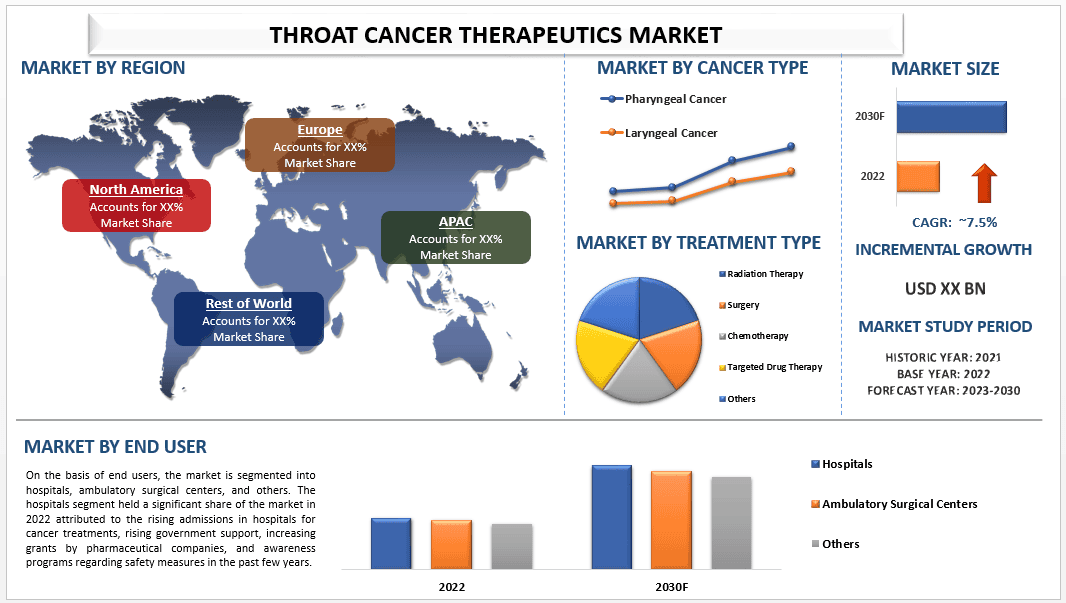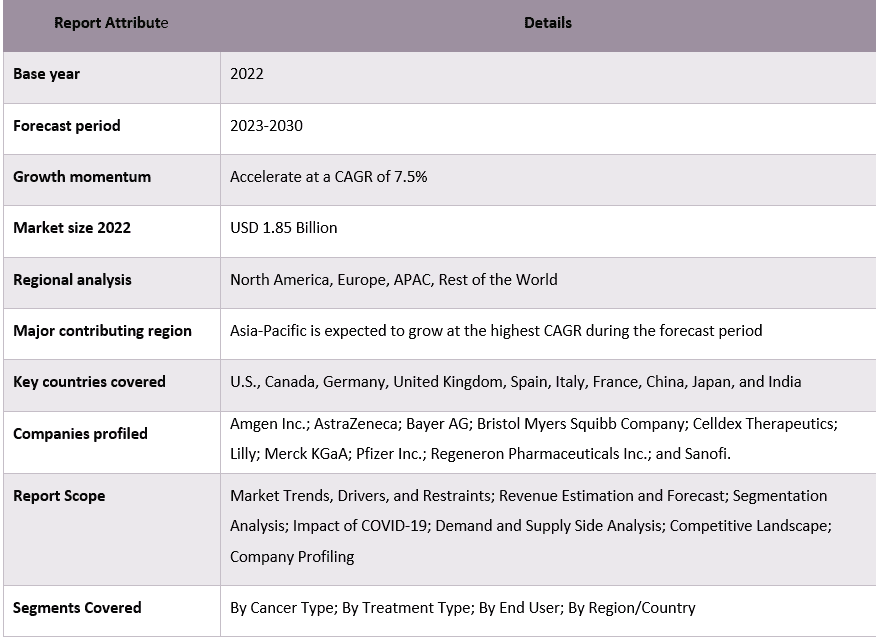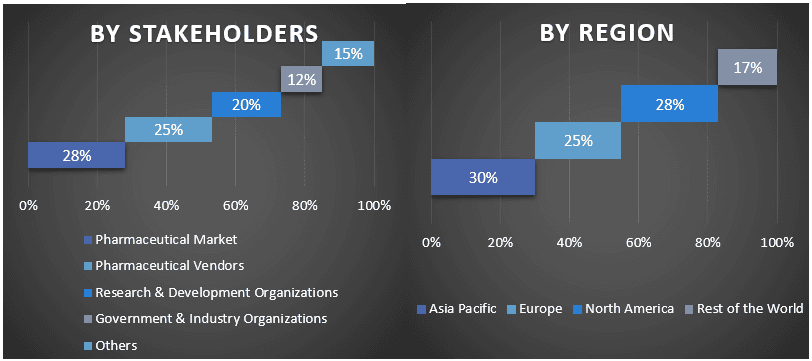咽頭がん治療薬市場:現状分析と予測(2023年~2030年)
癌の種類(咽頭癌および喉頭癌)の重視; 治療の種類(放射線療法、手術、化学療法、分子標的薬療法など); エンドユーザー(病院、外来手術センターなど); 地域/国

世界の咽頭がん治療薬市場は、予測期間中に約7.5%の উল্লেখযোগ্য成長率で成長すると予想されています。 咽頭がん治療薬サービスは、アルコールとタバコの消費量の増加により、治療薬市場で注目を集めました。これに加え、腫瘍科への投資や、咽頭がんに関する政府の啓発プログラムが近年大幅に増加しており、市場に機会を創出する主要な要因となっています。例えば、2021年2月には、米国に拠点を置く、がん治療のための精密医療の提供に注力する企業であるKura Oncology, Inc.が、FDAからtipifarnib薬の承認を受けました。この薬は、転移性または再発性HRAS変異頭頸部扁平上皮癌に苦しむ患者に治療を提供します。 咽頭がんに関する啓発プログラムの急増、喫煙人口の増加、アルコール依存症文化の高まりなど、予測期間中に市場を牽引するのに役立つ他の多くの要因も特定されました。
Amgen Inc.; AstraZeneca; Bayer AG; Bristol Myers Squibb Company; Celldex Therapeutics; Lilly; Merck KGaA; Pfizer Inc.; Regeneron Pharmaceuticals Inc.; Sanofiは、市場の主要なプレーヤーの一部です。これらのプレーヤーは、ハイテクで革新的な製品/技術を顧客に提供するために、いくつかのM&Aとパートナーシップを行っています。
レポートで提示されるインサイト
「がんの種類別では、咽頭がんカテゴリーが予測期間中に高いCAGRを目撃する」
がんの種類に基づいて、市場は咽頭がんと喉頭がんに二分されます。喫煙や噛みタバコなどのタバコの使用、過度のアルコール摂取の増加傾向があるため、咽頭がんセグメントは予測期間中に高いCAGRで成長すると予想されます。また、果物や野菜が不足した食事、胃食道逆流症、職業性有毒物質への曝露、およびヒトパピローマウイルスおよびエプスタインバーウイルスを含むウイルス感染症の発生率の増加も、市場での成長を促進しています。腫瘍専門の製薬会社は、患者の健康のために、強化された治療薬を発売し続けています。例えば、米国がん協会の口腔および中咽頭がんに関する最新の見積もりによると、2023年の米国の口腔または中咽頭がんの新規症例は約54,540件です。 したがって、がんの種類の中で、咽頭カテゴリーは予測期間中に高いCAGRを目撃すると予想されます。
「治療の種類別では、化学療法が2022年に市場で大きなシェアを占めた」
治療の種類に基づいて、市場は放射線療法、手術、化学療法、分子標的薬療法、およびその他に分類されます。化学療法セグメントは、がん細胞に放射線を送るためにX線と陽子を使用してがん細胞を殺す化学療法の最大の有効性により、2022年に市場を支配しています。さらに、世界的に咽頭がんの発生率が増加しており、このセグメントの推進要因となっています。例えば、mesothelioma.comの2023年6月のレポートによると、米国では毎年がん患者の25%が化学療法を受けており、治療を見送る場合と比較して、化学療法は一部の患者の生存率を2倍にすることができます。 したがって、治療の種類の中で、化学療法は2022年に市場の大きなシェアを占めました。
咽頭がん治療薬市場レポートの範囲

「エンドユーザー別では、病院セグメントが予測期間中に高いCAGRで成長する」
エンドユーザーに基づいて、市場は病院、外来手術センター、およびその他にセグメント化されています。咽頭がんの有病率の急増により入院が増加し、外科的手術が増加しているため、病院セグメントは予測期間中に高いCAGRで成長すると予想されます。腫瘍科への支出の増加、咽頭がんに対する患者の意識レベルの向上、高度な病院インフラの利用可能性、先進国における専門病院の増加など、他の要因も予測期間中のセグメントの優位性をもたらすと予想されます。例えば、2023年6月には、北インドに拠点を置く単一センター病院のがん登録研究には、2020年12月までに病院を受診したすべての主に診断された頭頸部がん症例が含まれており、合計574件の確認された頭頸部がん症例が報告されました。 したがって、エンドユーザーの中で、病院カテゴリーは予測期間中に高いCAGRを目撃すると予想されます。
「地域別では、北米が2022年に市場の大きなシェアを占めた」
北米は、煙害の増加、アルコール消費量の増加、効果的な咽頭がん治療薬の開発への投資の増加により、2022年の現在のシナリオで市場を支配しています。政府機関は、患者に効率的なケアを提供するために、咽頭がんの啓発プログラムを開始しています。例えば、2023年7月、米国癌学会と米国頭頸部学会は、モントリオールで第3回のAACR-AHNS頭頸部がん合同会議を開催し、最新の研究を発表し、頭頸部がんの生物学、検出、画像処理、予防、治療に関する重要な最新情報を提供しました。AACRはまた、頭頸部がんに関連する有望な研究を追求する研究者に研究助成金を授与しています。 したがって、地域の中で、北米が2022年に市場の大きなシェアを占めました。
Q1: 咽頭がん治療薬市場の現在の市場規模と成長の可能性は何ですか?
回答: 咽頭がん治療薬市場は、2022年に65億米ドルと評価され、予測期間(2023〜2030年)中に8.5%のCAGRで成長すると予想されています。
Q2: 咽頭がん治療薬市場の成長の推進要因は何ですか?
アルコールとタバコの消費量の増加、咽頭がんに関する啓発プログラムの急増、および腫瘍科への投資の増加が、咽頭がん治療薬市場の成長の推進要因です。
Q3: がんの種類別の咽頭がん治療薬市場で最大のシェアを占めるセグメントはどれですか?
回答: 喉頭がんセグメントが、がんの種類別の咽頭がん治療薬市場で最大のシェアを占めています。
Q4: 咽頭がん治療薬市場における新たな技術とトレンドは何ですか?
回答: 移植および細胞療法、分子診断アッセイおよびエピジェネティクス製品、デジタルライトサイクラーシステムPCR、およびAI統合診断システムは、咽頭がん治療薬市場における新たな技術とトレンドです。
Q5: どの地域が咽頭がん治療薬市場を支配しますか?
回答: 北米は予測期間中に市場を支配すると予想されます。
Q6: 咽頭がん治療薬市場で活動している主要なプレーヤーは誰ですか?
回答: Amgen Inc.; AstraZeneca; Bayer AG; Bristol Myers Squibb Company; Celldex Therapeutics; Lilly; Merck KGaA; Pfizer Inc.; Regeneron Pharmaceuticals Inc.; Sanofiは、咽頭がん治療薬市場で活動している主要なプレーヤーです。
このレポートを購入する理由:
- この調査には、認証された主要な業界専門家によって検証された市場規模と予測分析が含まれています。
- このレポートは、業界全体のパフォーマンスを一目で迅速に確認できます。
- このレポートでは、主要な財務、製品ポートフォリオ、拡張戦略、および最近の開発に主な焦点を当てて、著名な業界ピアの詳細な分析を取り上げています。
- 業界で優勢な推進要因、制約、主要なトレンド、および機会の詳細な調査。
- この調査では、さまざまなセグメントにわたる市場を包括的に取り上げています。
- 業界の地域レベルの分析を深く掘り下げます。
カスタマイズオプション:
世界の咽頭がん治療薬市場は、要件またはその他の市場セグメントに応じてさらにカスタマイズできます。これに加えて、UMIは、お客様が独自のビジネスニーズを持っている可能性があることを理解しているため、お客様の要件に完全に適合するレポートを入手するために、お気軽にお問い合わせください。
目次
咽頭癌治療薬市場分析(2023年~2030年)の調査方法
世界の咽頭癌治療薬市場の過去の市場を分析し、現在の市場を推定し、将来の市場を予測することは、世界の主要地域における咽頭癌治療薬の採用状況を作成および分析するために行われた3つの主要なステップでした。過去の市場数値を収集し、現在の市場規模を推定するために、徹底的な二次調査が実施されました。次に、これらの洞察を検証するために、多数の調査結果と仮定が考慮されました。さらに、世界の咽頭癌治療薬市場のバリューチェーン全体にわたる業界の専門家との徹底的な主要インタビューも実施されました。主要インタビューを通じて市場数の仮定と検証を行った後、トップダウン/ボトムアップアプローチを採用して、市場全体の規模を予測しました。その後、市場の内訳とデータの三角測量方法を採用して、業界のセグメントとサブセグメントの市場規模を推定および分析しました。詳細な方法論を以下に説明します。
過去の市場規模の分析
ステップ1:二次資料の詳細な調査:
年次報告書と財務諸表、業績プレゼンテーション、プレスリリースなどの企業内部の情報源、およびジャーナル、ニュースと記事、政府刊行物、競合他社の刊行物、セクターレポート、サードパーティのデータベース、その他の信頼できる刊行物などの外部の情報源を通じて、咽頭癌治療薬市場の過去の市場規模を取得するために、詳細な二次調査が実施されました。
ステップ2:市場セグメンテーション:
咽頭癌治療薬市場の過去の市場規模を取得した後、主要地域におけるさまざまなセグメントとサブセグメントの過去の市場に関する洞察とシェアを収集するために、詳細な二次分析を実施しました。主要なセグメントは、癌の種類、治療の種類、エンドユーザー、および地域としてレポートに含まれています。さらに、地域における試験モデルの全体的な採用状況を評価するために、国レベルの分析を実施しました。
ステップ3:要因分析:
さまざまなセグメントとサブセグメントの過去の市場規模を取得した後、咽頭癌治療薬市場の現在の市場規模を推定するために、詳細な要因分析を実施しました。さらに、咽頭癌治療薬の癌の種類、治療の種類、エンドユーザー、および地域などの従属変数と独立変数を使用して、要因分析を実施しました。世界の咽頭癌治療薬市場セクターにおけるトップパートナーシップ、合併と買収、事業拡大、および製品の発売を考慮して、需要側と供給側のシナリオについて徹底的な分析を実施しました。
現在の市場規模の推定と予測
現在の市場規模の算出:上記の3つのステップからの実用的な洞察に基づいて、現在の市場規模、世界の咽頭癌治療薬市場における主要なプレーヤー、およびセグメントの市場シェアに到達しました。必要なすべてのパーセンテージシェア分割と市場の内訳は、上記の二次的なアプローチを使用して決定され、主要なインタビューを通じて検証されました。
推定と予測:市場の推定と予測では、推進要因と傾向、制約、および利害関係者が利用できる機会を含むさまざまな要因に重みが割り当てられました。これらの要因を分析した後、関連する予測手法(つまり、トップダウン/ボトムアップアプローチ)を適用して、世界の主要市場全体のさまざまなセグメントとサブセグメントの2030年の市場予測に到達しました。市場規模の推定に採用された調査方法には以下が含まれます。
- 収益(米ドル)と国内の主要市場における咽頭癌治療薬市場の採用率の観点からの業界の市場規模
- 市場セグメントとサブセグメントのすべてのパーセンテージシェア、分割、および内訳
- 提供される製品の観点から見た、世界の咽頭癌治療薬市場における主要なプレーヤー。また、急速に成長している市場で競争するためにこれらのプレーヤーが採用した成長戦略
市場規模とシェアの検証
一次調査:主要な地域全体で、トップレベルのエグゼクティブ(CXO/VP、営業責任者、マーケティング責任者、運用責任者、地域責任者、カントリーヘッドなど)を含む、Key Opinion Leaders(KOL)との詳細なインタビューが実施されました。次に、一次調査の結果を要約し、述べられた仮説を証明するために統計分析を実行しました。一次調査からのインプットは二次的な調査結果と統合され、それによって情報が実用的な洞察に変わりました。
さまざまな地域における主要な参加者の分割

市場エンジニアリング
データ三角測量技術を採用して、市場全体の推定を完了し、世界の咽頭癌治療薬市場の各セグメントおよびサブセグメントの正確な統計数値を導き出しました。世界の咽頭癌治療薬市場における癌の種類、治療の種類、エンドユーザー、および地域の分野におけるさまざまなパラメータと傾向を調査した後、データはいくつかのセグメントとサブセグメントに分割されました。
世界の咽頭癌治療薬市場調査の主な目的
世界の咽頭癌治療薬市場の現在および将来の市場動向は、調査で正確に指摘されました。投資家は、調査で実施された定性的および定量的分析に基づいて、投資に関する裁量を判断するための戦略的な洞察を得ることができます。現在および将来の市場動向は、地域レベルでの市場の全体的な魅力を決定し、産業参加者が未開拓の市場を活用して、ファーストムーバーの利点から恩恵を受けるためのプラットフォームを提供しました。調査のその他の定量的な目標には、以下が含まれます。
- 価値(米ドル)の観点から、咽頭癌治療薬市場の現在および予測市場規模を分析します。また、さまざまなセグメントとサブセグメントの現在および予測市場規模を分析します。
- 調査のセグメントには、癌の種類、治療の種類、エンドユーザー、および地域が含まれます。
- 咽頭癌治療薬業界の規制の枠組みを定義および分析します。
- さまざまな仲介業者の存在に伴うバリューチェーンを分析するとともに、業界の顧客および競合他社の行動を分析します。
- 主要地域における咽頭癌治療薬市場の現在および予測市場規模を分析します。
- レポートで調査された地域の主要国には、アジア太平洋、ヨーロッパ、北米、およびその他の地域が含まれます。
- 咽頭癌治療薬市場の企業プロファイル、および急速に成長している市場で持続するために市場プレーヤーが採用した成長戦略
- 業界の詳細な地域レベル分析
関連 レポート
この商品を購入したお客様はこれも購入しました










